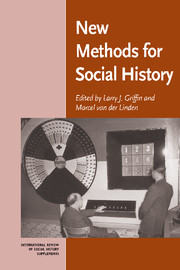Book contents
- Frontmatter
- Contents
- NOTES ON CONTRIBUTORS
- Introduction
- Temporally Recursive Regression and Social Historical Inquiry: An Example of Cross-Movement Militancy Spillover
- Using Event History Analysis in Historical Research: With Illustrations from a Study of the Passage of Women's Protective Legislation
- Incorporating Space into Social Histories: How Spatial Processes Operate and How We Observe Them
- Narrative as Data: Linguistic and Statistical Tools for the Quantitative Study of Historical Events
- The Logic of Qualitative Comparative Analysis
- Historical Social Network Analysis
- Historical Inference and Event-Structure Analysis
Introduction
Published online by Cambridge University Press: 04 August 2010
- Frontmatter
- Contents
- NOTES ON CONTRIBUTORS
- Introduction
- Temporally Recursive Regression and Social Historical Inquiry: An Example of Cross-Movement Militancy Spillover
- Using Event History Analysis in Historical Research: With Illustrations from a Study of the Passage of Women's Protective Legislation
- Incorporating Space into Social Histories: How Spatial Processes Operate and How We Observe Them
- Narrative as Data: Linguistic and Statistical Tools for the Quantitative Study of Historical Events
- The Logic of Qualitative Comparative Analysis
- Historical Social Network Analysis
- Historical Inference and Event-Structure Analysis
Summary
Our intent in publishing this collection of essays is to introduce historians to a set of quantitative and qualitative social science methods that have genuine, and as yet un- or under-explored, utility for historical inquiry. Believing that the potency of any methodology is best displayed through the analysis of actual historical cases, we called for our contributors to demonstrate their chosen method's logic and applicability by grounding their exposition in concrete historical happenings. Though we also asked them to use as expository vehicles historical cases that are significant on their own terms and of clear relevance to social historians, the essays’ actual substantive pay-off is apt to be less important than their ability to display in an accessible fashion when, why and how the application of various formal methods may generate deeper, more satisfying explanations and interpretations of historical happenings.
Admittedly, a call to contemporary historians to reconsider the possible value to them of formal social science methodologies comes at a peculiar time in our intellectual life. Analytical formalism in history seems on the wane, and, at best, social science and history have shared a checkered and uneasy relationship over the last century and a half. Early sociology, for example, borrowed from, leaned on, or in other ways was in conversation with history, even if some of the discipline's founders paradoxically used history in an ahistorical manner; that is, as a “storehouse of samples” in Barrington Moore's apt phrase, a mere testing ground for grand sociological theory rather than something to be comprehended in its own right.
- Type
- Chapter
- Information
- New Methods for Social History , pp. 3 - 8Publisher: Cambridge University PressPrint publication year: 1999



